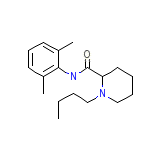Bupivacaine




Bupivacaine Brand names, Bupivacaine Analogs
- (+-)-Bupivacaine
- Anekain
- Bloqueina
- Bupivacaina [INN-Spanish]
- Bupivacaine HCL
- Bupivacaine HCL KIT
- Bupivacainum [INN-Latin]
- Bupivacine HCL Preservative Free
- Bupivan
- Carbostesin
- Chirocaine
- DL-Bupivacaine
- LAC-43
- Marcaina
- Marcaine
- Marcaine HCL
- Marcaine Spinal
- Sensorcaine
- Sensorcaine Forte
- Sensorcaine-MPF
- Sensorcaine-MPF Spinal
- cBupivacaine
Bupivacaine Brand Names Mixture
- Marcaine E 0.25% Liq Prt (Bupivacaine Hydrochloride + Epinephrine Bitartrate)
- Marcaine E 2.5 Mg/Ml (Bupivacaine Hydrochloride + Epinephrine Bitartrate)
- Marcaine E 5.0 Mg/Ml (Bupivacaine Hydrochloride + Epinephrine Bitartrate)
- Marcaine E Liq Prt 0.50% (Bupivacaine Hydrochloride + Epinephrine Bitartrate)
- Sensorcaine 0.5% with Epinephrine (Bupivacaine Hydrochloride + Epinephrine Bitartrate)
- Sensorcaine Forte (Bupivacaine Hydrochloride + Epinephrine Bitartrate)
Bupivacaine Chemical_Formula
C18H28N2O
Bupivacaine RX_link
http://www.rxlist.com/cgi/generic2/bupivacaine.htm
Bupivacaine fda sheet
Bupivacaine msds (material safety sheet)
Bupivacaine Synthesis Reference
No information avaliable
Bupivacaine Molecular Weight
288.428 g/mol
Bupivacaine Melting Point
107-108 oC
Bupivacaine H2O Solubility
2400 mg/L
Bupivacaine State
Solid
Bupivacaine LogP
3.987
Bupivacaine Dosage Forms
Liquid (for injection); Solution
Bupivacaine Indication
For the production of local or regional anesthesia or analgesia for surgery, for oral surgery procedures, for diagnostic and therapeutic procedures, and for obstetrical procedures.
Bupivacaine Pharmacology
Bupivacaine is a widely used local anesthetic agent. Bupivacaine is often administered by spinal injection prior to total hip arthroplasty. It is also commonly injected into surgical wound sites to reduce pain for up to 20 hours after surgery. In comparison to other local anesthetics it has a long duration of action. It is also the most toxic to the heart when administered in large doses. This problem has led to the use of other long-acting local anaesthetics:ropivacaine and levobupivacaine. Levobupivacaine is a derivative, specifically an enantiomer, of bupivacaine. Systemic absorption of local anesthetics produces effects on the cardiovascular and central nervous systems. At blood concentrations achieved with therapeutic doses, changes in cardiac conduction, excitability, refractoriness, contractility, and peripheral vascular resistance are minimal. However, toxic blood concentrations depress cardiac conduction and excitability, which may lead to atrioventricular block, ventricular arrhythmias and to cardiac arrest, sometimes resulting in fatalities. In addition, myocardial contractility is depressed and peripheral vasodilation occurs, leading to decreased cardiac output and arterial blood pressure. Following systemic absorption, local anesthetics can produce central nervous system stimulation, depression or both.
Bupivacaine Absorption
The rate of systemic absorption of local anesthetics is dependent upon the total dose and concentration of drug administered, the route of administration, the vascularity of the administration site, and the presence or absence of epinephrine in the anesthetic solution.
Bupivacaine side effects and Toxicity
The mean seizure dosage of bupivacaine in rhesus monkeys was found to be 4.4 mg/kg with mean arterial plasma concentration of 4.5 mcg/mL. The intravenous and subcutaneous LD 50 in mice is 6 to 8 mg/kg and 38 to 54 mg/kg respectively. Recent clinical data from patients experiencing local anesthetic induced convulsions demonstrated rapid development of hypoxia, hypercarbia, and acidosis with bupivacaine within a minute of the onset of convulsions. These observations suggest that oxygen consumption and carbon dioxide production are greatly increased during local anesthetic convulsions and emphasize the importance of immediate and effective ventilation with oxygen which may avoid cardiac arrest.
Bupivacaine Patient Information
When appropriate, patients should be informed in advance that they may experience temporary loss of sensation and motor activity, usually in the lower half of the body following proper administration of caudal or lumbar epidural anesthesia. Also, when appropriate, the physician should discuss other information including adverse reactions in the Sensorcaine package insert.
Bupivacaine Organisms Affected
Humans and other mammals














